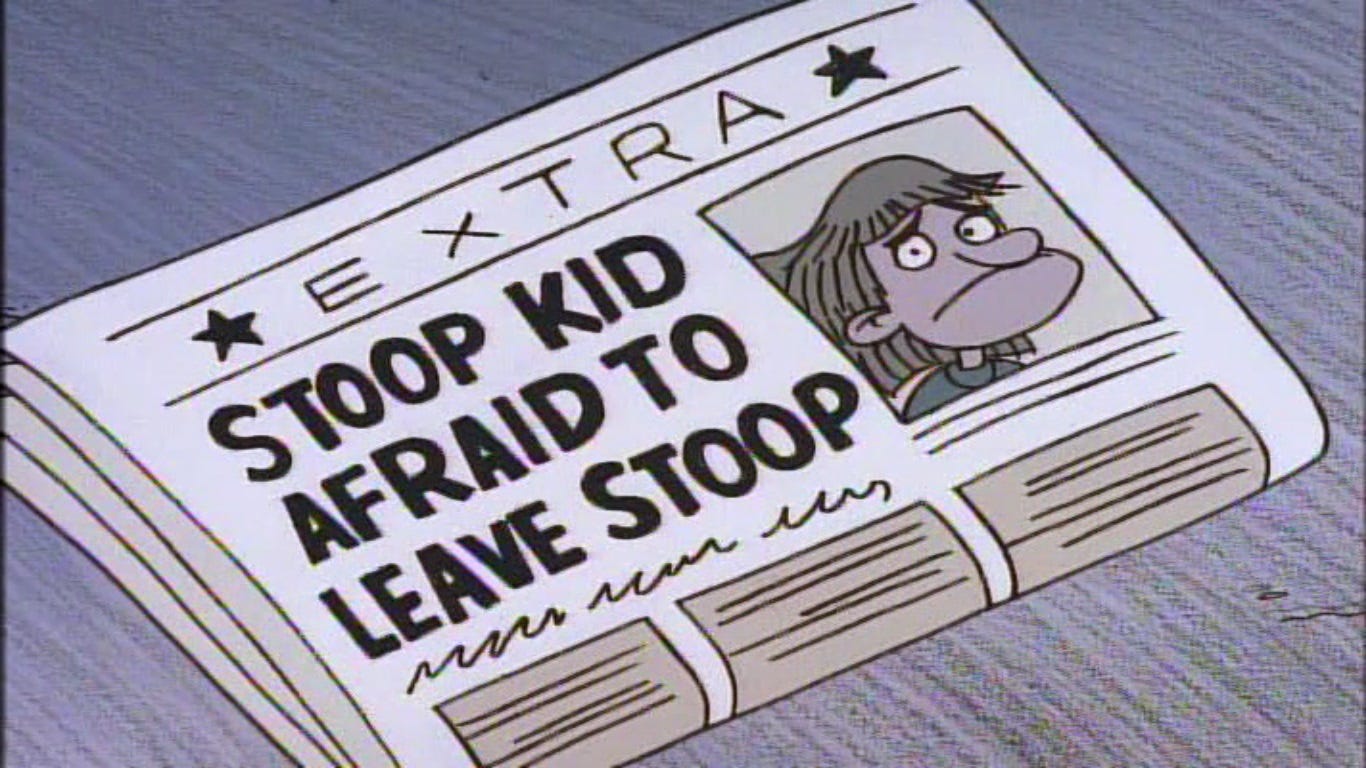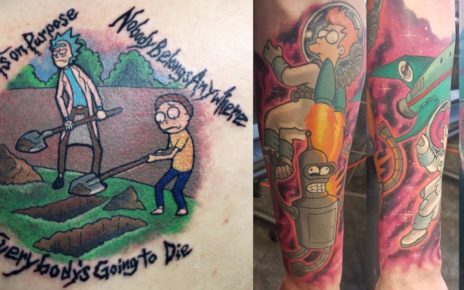“Hey, move it or lose it, tubby!”
The boy with the bowlcut shouts at me as I near his doorstep. It’s an odd entranceway he seems to inhabit, and as I approach, his verbal assault continues, decibels climbing. It’s weird, I have earbuds in but I can hear him as clear as day. A couple passes me and their conversation is muffled, yet the boy’s voice reverberates through my head.
The hammock he lounges on hangs in the portico. That’s one way to afford Brooklyn, I think to myself as he leans down and picks up an empty can. Oblivious to his intent, I glance at the gargoyles hunched ominously over the doorframe.
“Don’t even look at my stoop, fatso!”
Middle schoolers have a knack for cutting right to your core and picking out the one thing you’re self-conscious about. He arches his arm back and slings the can in my direction, and I recoil for a fraction of a second. A cab slams on its brakes down the block and honks loudly, waking me from my daydream. The boy disappears into the Brooklyn brownstone.
Why can’t I get Stoop Kid out of my head?
Stoop Kid. That magnificent agoraphobic bastard. While not a major character in Hey Arnold!, Stoop Kid has proved crucial to its mythos. His story is the first urban legend shared with us on the show, and it’s told by none other than Gerald, the keeper of all tall tales throughout the series: Pigeon Man, Haunted Train, Four-Eyed Jack—the works. Every episode featuring an urban legend is particularly memorable and, to me, Stoop Kid set the standard for all those that came after.
Swinging in his hammock, tossing empty cans of some mystery substance to the curb, berating passerby regardless of age, race, or gender. He’s not the most enviable character, is he? If anything, the small world in which he lives, coupled with the hostility he shows toward anyone who comes near enough to enter it, evokes in the viewer a pity.

And yet, for a reason I could not pinpoint, I wished to be like him. What about him, after all, could I have found desirable — aside from the plaid green vest taken right out of Kurt Cobain’s closet and the kind of notoriety that only Kanye West enjoys? After all, you don’t make the paper twice in a single episode without making a name for yourself about town.
But it wasn’t the local fame or the spunk that drew me to Stoop Kid. It was the struggle he overcame. His childhood was clearly fraught with trauma of some kind that caused him to shelter himself on the steps of his Hillwood walkup. Arnold, being the kind soul he is, helped him channel his inner “Little Engine That Could” and showed Stoop Kid that the world beyond the stoop is worth experiencing.
I wanted that too. Or so I thought.
While I believe that no one really has it easy growing up, my childhood was as close to care-free as could be. Committed parents in a stable household in a well-to-do town on Long Island? I couldn’t have asked for more. And yet one night, during the worst year of my life, I found myself sitting in my studio apartment, asking for more—by wanting less.
I had just moved into the studio in a new city, Chicago, and like Stoop Kid, I was alone. For the first time, I had to be self-reliant. It wasn’t easy — unlike the Kid, I didn’t have an apple tree growing by my window for free, convenient nourishment.
As time went on, that self-sufficiency became a struggle. Weeks passed, and I still hadn’t saved up enough to buy the necessities that make up a home. No furniture, no nothing. My job began to wear on me, and by the end of a broiling summer, I found myself zoning out in the midst of a four-hour Mad Men binge on a week night. Something was wrong.
Standing at the edge of Lake Michigan on a clear Sunday night in August, I thought about the next day—when, like every other day, I’d walk into work and stare at nothing while slouched over my desk for eight hours. I texted my boss that night and took a leave of absence. I felt numb.
Over the course of the next year, I’d have many a late-night call with my parents about my situation. I tried to glean as much information from their collective experience as possible. One night, during the Polar Vortex of 2014, sitting in my studio I told my dad over the phone, “I wish I had it harder growing up.”
I had just off-handedly asked someone who’d grown up knowing true struggle for something I couldn’t even begin to understand. I was that lost.
I couldn’t get Stoop Kid out of my mind. I wished for the kinds of problems Stoop Kid had as a kid—abandonment, becoming a bully in reaction to that abandonment, having the veneer of superiority wiped away by becoming the bullied, and the opportunity to learn from it all.
In my head, it seemed that if I had faced something crueler in my cushy youth — abandonment, or loss, or poverty, or worse — I would have felt more prepared for the difficulties of adulthood. Stronger, wiser. An empty studio with an empty bank account pinned to an empty job would have felt like a walk in the park.
My dad listened quietly as I complained, with a patience I didn’t appreciate at the time. Then he spoke:
“Trust me, son. You don’t want that.”
My father knew from personal experience that the youth I pined for wasn’t romantic in the way I believed. Born and raised in Bay Ridge to Irish immigrant parents, his childhood was far from perfect.
Despite going to the same prep school as James Joyce, my grandfather — my father’s father — was only able to find work as a bus driver once he arrived in New York City after flying for the Royal Air Force in World War II. The daily monotony took its toll over the years, and by the time my father was 12, my grandfather had taken to hard drinking. As the oldest of the kids, my dad was tasked with staying up late with my grandmother, helping her to deal with his father after he returned from a bender.
The other neighborhood kids of Bay Ridge didn’t have it any easier. My dad tells stories of acquaintances and friends whose lives ended in jail or under the muzzle of a policeman’s gun. One such friend once approached my father with a business card emblazoned with a revolver and the words “South Brooklyn Boys” underneath, asking for his membership in the newly formed gang. My dad, wisely, declined.
He and his friends had been through what Stoop Kid had—if not worse—and he knew its costs. I didn’t.
With my iPhone’s battery draining by the minute, I began to realize how asinine my lamentations must have sounded to my father—and how they might have sounded to Stoop Kid, had he been listening in on the call.
The idealization of struggling through life — from the romanticism of the hobo lifestyle, to the decades-long craze over the Beats and their literature, to romanticization of violent poverty in everything from gangster rap to the popular understanding of The Wire—is generally perpetuated by folks like me, who have encountered relatively few obstacles so far in their young lives. And it’s total bullshit.
A life of struggle doesn’t give you On the Road. More often than not, it gives you fear and baggage. Baggage that keeps you on your stoop, throwing cans at the rest of the world to hide how much it terrifies you.
In my mind, my experiences in Chicago had become a way to pay for the privileges of my youth. I resented it, but still, it felt like a cosmic necessity. The scales of privilege should balance out at some point, right? Isn’t that justice?
Maybe not. But if nothing else, it became a lesson: be grateful for what you’re given.
Nowadays, I know better than to wish for worse. I remember to be thankful for what I had growing up—a warm home and a loving and well-off family, who had protected and cared for me so well that the first time I ever truly struggled was after I was allowed to wander out into the world on my own. I hope that first time, hard as it was, will not be the last. There’s a lot more to be learned, and an awful lot of stoops out there to see.





